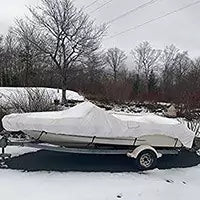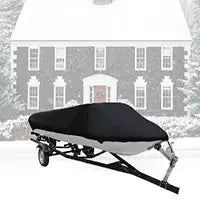How to cover a bass boat outside snow?

How to Properly Cover a Bass Boat for Outdoor Winter Storage in Snow
How to cover a bass boat?
How to cover a bass boat outside snow?

As an avid bass angler, you want to maximize your fishing season. But living in an area with harsh winters means you'll need to store your boat outside in freezing temps and heavy snow at times. Protecting your investment properly during off-season storage is crucial to having it ready to go at the first thaw. Follow this comprehensive guide on how to cover a bass boat outside in the snow.
Why Use a Bass Boat Cover in Snow?
Exposing your bass boat to snow, ice, and winter precipitation without a cover leads to a number of issues including:
- Snow buildup can collapse and crack the hull or damage hardware.
- Ice accumulation can freeze hatches, controls, electrical - causing spring failures.
- Freezing and thawing moisture seeps inside leading to winter kill.
- Uncovered upholstery and carpeting will become waterlogged from melting snow.
- Decals and gelcoat fade and degrade faster without UV protection.
A water-resistant, properly secured bass boat cover specifically made for winter provides essential protection against these threats when storing your boat outside under heavy snow.

Choosing the Best Winter Bass Boat Cover
Not just any cover will do the job when it comes to outdoor storage in extreme winter weather - you need one made to stand up to heavy snow, ice, and wind:
- Look for durable 600 denier polyester or marine grade vinyl that resists snow load collapse and abrasion from blowing ice crystals.
- Double-piped seams prevent seam failures that could unzip the cover's enclosure during winter winds.
- Choose a cover with a high snow load rating (30+ lbs per sq. ft) and wind resistance rated for your typical winter conditions.
- Seek out materials like slick Morsetaire that prevent problematic ice and snow buildup on the cover surface.
- Opt for vented, breathable fabric panels to allow moisture escape and prevent interior condensation that leads to ice formation inside the boat.
Take Time for Proper Winterization
Before putting on that winter cover, be sure to properly winterize your bass boat:
- Flush and fog the motor, add fuel stabilizer and perform all engine winterization procedures.
- Disconnect and charge batteries, coat terminals to prevent corrosion over the winter.
- Remove and securely store electronics, cushions, drain plugs and accessories for the winter.
- Give the boat a thorough wash and wax to protect the gelcoat under the cover during winter months.
Taking time for proper winterizing will ensure your bass boat stays protected while stored under the cover.
Additional Useful Winter Cover Features
Here are some other beneficial cover features for heavy snow protection:
- Padded wings cushion the hull from abrasion by blowing snow and ice.
- Forward vents at the windshield allow wiper access to clear snow without uncovering.
- Quick-release straps and integrated tie-downs keep the cover securely attached during winter winds.
- A storage bag keeps the cover clean and dry when not on the boat.
Necessary Preparation Before Covering
Before putting on that winter cover, make sure to:
- Give the boat a thorough cleaning and waxing to protect the gelcoat under the cover.
- Remove and properly store cushions, electronics, drain plugs and other accessories for winter.
- Disconnect and charge batteries, then spray terminals with protectant like CRC Marine 66 to prevent corrosion.
- Flush the motor, add fuel stabilizer, and perform winterization procedures as required.
- Install proper hull support stands under trailer bunks to prevent damage from long-term ground contact.
Proper Cover Installation Steps
When putting on the winter bass boat cover, follow these tips:
- Park trailer on level ground sheltered from prevailing winds if possible.
- Inspect cover for damage and test all strapping is securely fastened.
- Unroll cover and place over the boat from bow to stern for easier positioning.
- Pull cover tight at all points and secure all quick-release straps and buckles.
- Tie all integrated strap ends to trailer frame to keep anchored in wind gusts.
- Make sure all hardware, hinges, handles, etc are covered - if not, adjust.
- Use optional pole supports to keep loose areas like the stern lifted off touch points.
Regular Checks and Maintenance
Check on your covered bass boat periodically throughout winter and after major snowstorms:
- Ensure straps remain cinched tight and tie-downs secured after snow or wind events.
- Clear any heavy snow accumulation to prevent overloading from weight.
- Carefully remove any snow around wipers, vents and hardware access points.
- Inspect for moisture or ice buildup inside the boat. Dry out and ventilation if found.
- Wash the cover monthly using cool water and mild soap, allow to fully dry.
- Touch up any nicks, cuts or seam leaks with waterproof repair tape.

Find the Right Winter Bass Boat Protection
Storing your prized bass fishing asset outside under heavy winter conditions demands a rugged, snow-rated cover designed specifically to protect against snow, ice, wind and freezing temperatures. Follow the winter cover selection tips, prep work, proper installation, and maintenance practices outlined above to keep your boat safe from the elements until fishing season returns. Don't leave it vulnerable - keep it fully covered!



